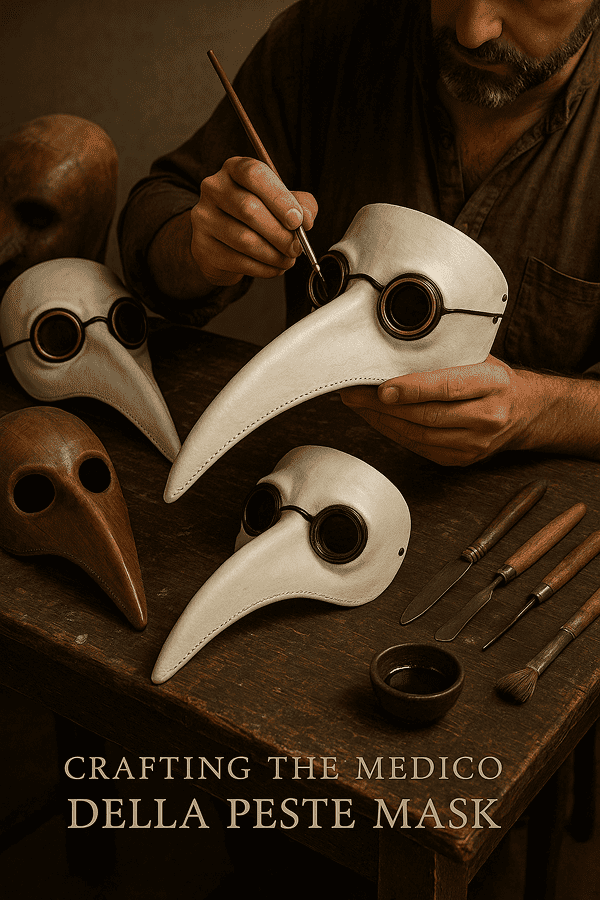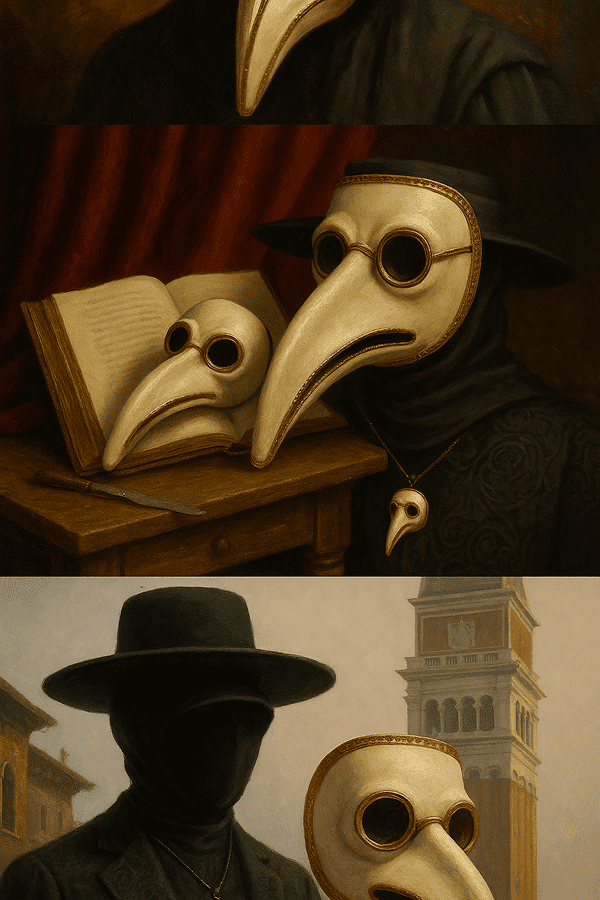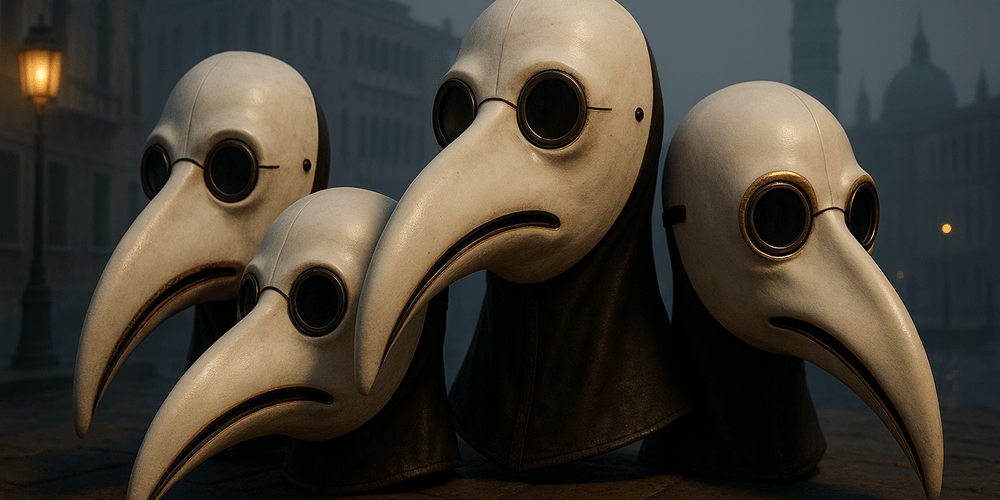The Medico della Peste Mask, also known as the Plague Doctor Mask, is one of the most haunting and instantly recognizable symbols of Venetian history and Carnivale tradition. Characterized by its long, beak-like nose, round eye holes, and stark white color, this mask stands apart from the more ornate and decorative Venetian masks. The Medico della Peste Mask is closely associated with the city of Venice, particularly during the devastating outbreaks of plague in the 17th century. Originally designed for practical, medical use, the mask has evolved into an iconic element of Venetian masquerade and global popular culture.
Historical Origins: The Story Behind the Medico della Peste Mask
The origins of the Medico della Peste Mask trace back to the 17th century, when Venice and much of Europe were repeatedly ravaged by plague. The name “Medico della Peste” literally means “Plague Doctor” in Italian. The mask was part of a protective costume designed by French physician Charles de Lorme in 1619. This distinctive mask was intended to protect doctors from airborne contagions: the long beak was filled with aromatic herbs, believed to purify the air, while glass lenses shielded the eyes. Over time, the mask’s design evolved, becoming both a symbol of fear and a strange sort of reassurance in Venetian society. Historical artworks, medical treatises, and preserved costumes in museums document the mask’s practical and cultural journey. In the context of Venice’s Carnival, the Medico della Peste Mask eventually joined the ranks of other iconic masks, such as the mysterious Moretta Mask.
Cultural Significance and Symbolism: The Meaning of the Plague Doctor Mask
In Venetian culture, the Medico della Peste Mask holds a unique place at the intersection of history, medicine, and myth. On one level, it represents the city’s struggle with disease, mortality, and the limits of human knowledge. The mask’s beaked profile became a symbol of both terror and hope, embodying the mystery and fear surrounding the plague. Over the centuries, it has come to symbolize the themes of anonymity, transformation, and the hidden self, common to all Venetian masks. Myths and urban legends grew around the mask, from tales of haunted doctors to stories of miraculous cures. Socially, the mask’s use in Carnival allowed Venetians to play with notions of life and death, parodying the figure of the doctor and exploring the boundaries between fear and festivity.
Materials and Craftsmanship: Creating the Medico della Peste Mask
Traditional Medico della Peste Masks are crafted from papier-mâché or lightweight leather, designed to be both durable and wearable. The creation process involves molding the long beak and round eyes, smoothing the surface, and painting it in stark white or sometimes with black details. Artisans use tools such as wooden molds, sculpting knives, and brushes to shape and decorate the mask. Some modern versions may feature glass lenses, metallic accents, or even gold leaf for decorative effect. While the basic design remains consistent, regional ateliers sometimes introduce subtle variations or additional embellishments. The stark color and minimalist design are essential to the mask’s impact, distinguishing it from more decorative Venetian masks like the Moretta Mask or Colombina.

Functions and Use: Medico della Peste Mask in Ritual, Theatre, and Carnival
The original function of the Medico della Peste Mask was practical: to protect plague doctors from infection during their rounds. The beak was stuffed with aromatic herbs, believed to filter out miasmas, while the rest of the costume covered the body from head to toe. Over time, as the actual medical use faded, the mask took on new roles in Venetian culture. During the Carnival of Venice, the Medico della Peste Mask became a popular costume, symbolizing both macabre history and the playful spirit of disguise. The mask is occasionally used in theatrical performances, parades, and themed events, where it represents the timeless dance between life and death. In recent years, the mask has appeared in films, literature, and art installations, drawing on its powerful historical and visual symbolism.
Regional Variations: Medico della Peste Mask Across Venice and Beyond
While the Medico della Peste Mask is quintessentially Venetian, subtle variations can be found in its design across different regions and workshops. Some masks feature longer or shorter beaks, different eye shapes, or additional decorative touches. In other parts of Italy and Europe, similar plague doctor masks were used, though often with local adaptations. When compared to other Venetian masks, such as the Moretta Mask, the Medico della Peste stands out for its starkness and its historical roots in real-life crisis rather than purely theatrical or festive invention.
Famous Examples and Collections: Where to See Medico della Peste Masks
Original and replica Medico della Peste Masks are preserved in several important museums, including the Museo di Palazzo Mocenigo in Venice, which specializes in Venetian costumes and masks. The Ca’ Rezzonico Museum and the Venice Carnival Museum also display historical examples and costumes. Private collectors and mask-makers in Venice often create detailed reproductions for the Carnival and for international exhibitions. Online platforms like toddmasks.com provide galleries and educational resources for those interested in learning more or acquiring authentic Medico della Peste Masks.
Influence on Art and Culture: The Plague Doctor Mask in Modern Imagination
The Medico della Peste Mask has had a lasting impact on visual arts, literature, and popular culture far beyond Venice. It is a recurring motif in paintings, novels, operas, and horror films, often symbolizing mystery, mortality, and the human response to catastrophe. In fashion and design, the mask’s silhouette has inspired avant-garde clothing, jewelry, and even architecture. The Medico della Peste Mask’s role in the preservation of Venetian cultural heritage is significant, as it connects contemporary Carnival celebrations with the city’s dramatic past. The mask also serves as a reminder of the resilience and creativity of Venetian society in the face of adversity.

Modern Status and Preservation: Keeping the Medico della Peste Tradition Alive
Today, the Medico della Peste Mask is crafted by skilled artisans and taught in Venetian mask-making schools. Workshops, masterclasses, and Carnival events help ensure that traditional techniques are passed on to new generations. Modern adaptations include the use of new materials, digital design, and reinterpretation in contemporary art. Museums, cultural organizations, and educational programs play a crucial role in preserving the history and craft of the Medico della Peste Mask, fostering appreciation and innovation.
Collecting and Acquisition: The Market for Medico della Peste Masks
The market for Medico della Peste Masks is active, with both authentic and reproduction masks available from Venetian workshops, museum shops, and online sources such as toddmasks.com. Prices range from affordable souvenirs to valuable artisan pieces, depending on craftsmanship, materials, and provenance. Collectors are encouraged to seek documentation of authenticity, support local artisans, and understand the ethical considerations of acquiring cultural artifacts. The popularity of the Medico della Peste Mask ensures its continued production and presence in collections worldwide.
